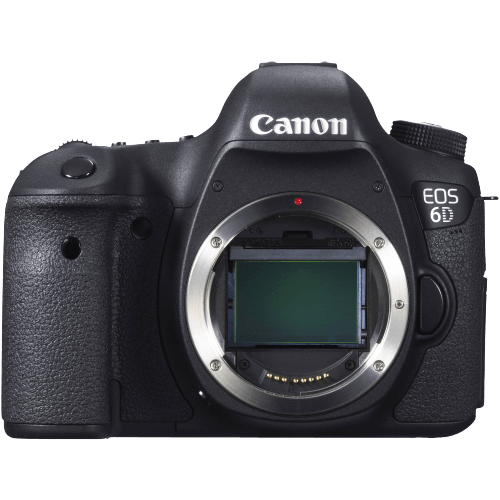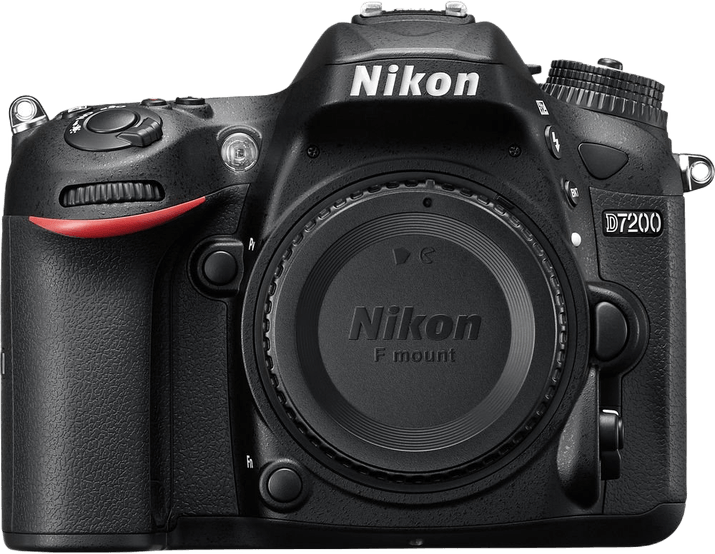Canon EOS 6D vs Nikon D7200 Comparison
Canon EOS 6D

Nikon D7200

The Nikon D7200 outperforms the Canon EOS 6D with a score of 68/100 compared to 59/100. Both cameras share the same DSLR camera type, similar weight (Canon EOS 6D: 770g, Nikon D7200: 765g), and dimensions (Canon EOS 6D: 145x111x71mm, Nikon D7200: 136x107x76mm). The Nikon D7200’s superior score is due to its more recent release in 2015, three years after the Canon EOS 6D’s 2012 debut. Additionally, the Nikon D7200 has a significantly lower launch price of $1200 compared to the Canon EOS 6D’s $2099.
Despite the lower score, the Canon EOS 6D still offers quality performance and remains a viable option for photographers. However, the Nikon D7200’s higher score, lower price, and more recent release make it the better choice between the two cameras.
Canon EOS 6D vs Nikon D7200 Overview and Optics
The Nikon D7200 takes the lead in optics with a score of 71/100, while the Canon EOS 6D scores 61/100. Both cameras have certain specifications in common, such as a CMOS sensor, no image stabilization, and similar processors – the Canon EOS 6D has a Digic 5+ processor, and the Nikon D7200 has an Expeed 4 processor.
The Nikon D7200 outshines the Canon EOS 6D in several aspects. Firstly, it has a higher megapixel count of 24.2 compared to the EOS 6D’s 20.2 megapixels. This allows for better image resolution and detail. Secondly, the Nikon D7200 has a faster shooting speed of 6 frames per second (fps), compared to the Canon EOS 6D’s 4.5 fps. This makes the D7200 more suitable for capturing fast-moving subjects. Additionally, the Nikon D7200 has a higher DXOMARK sensor score of 87, which signifies better overall image quality and low-light performance than the EOS 6D with a score of 82.
On the other hand, the Canon EOS 6D has a full-frame sensor, compared to the Nikon D7200’s APS-C sensor. This larger sensor size allows for better low-light performance and shallower depth of field, which can be advantageous for certain photographic styles, such as portraits.
Taking all factors into account, the Nikon D7200 proves to be superior in terms of optics due to its higher megapixel count, faster shooting speed, and better sensor score. However, the Canon EOS 6D’s full-frame sensor offers some advantages in low-light situations and depth of field control. Ultimately, the choice between these two cameras depends on the specific needs and preferences of the photographer.
Canon EOS 6D vs Nikon D7200 Video Performance
The Nikon D7200 emerges as the winner in terms of video capabilities, with a score of 70/100, compared to the Canon EOS 6D’s score of 43/100. Both cameras share common specifications, such as Full HD video resolution and maximum video dimensions of 1920 x 1080. However, the Nikon D7200 outperforms the Canon EOS 6D in two key areas: maximum video frame rate and built-in time-lapse functionality.
The Nikon D7200 has a maximum video frame rate of 60fps, which is twice the frame rate of the Canon EOS 6D, which only offers 30fps. This difference allows the Nikon D7200 to capture smoother and more detailed video, especially when recording fast-moving subjects or scenes. Additionally, the Nikon D7200 features built-in time-lapse functionality, enabling users to create stunning time-lapse videos without the need for external accessories or software. This feature is absent in the Canon EOS 6D, which may require additional equipment or post-processing to achieve similar results.
Despite the lower score, the Canon EOS 6D still maintains its position as a competent camera for video recording. However, its limitations in frame rate and lack of built-in time-lapse functionality make it less versatile than the Nikon D7200. As a result, users seeking enhanced video capabilities should consider the Nikon D7200, while those content with basic video recording may find the Canon EOS 6D sufficient for their needs.
In comparing the video capabilities of the Canon EOS 6D and the Nikon D7200, the Nikon D7200 is clearly the better choice due to its higher frame rate and built-in time-lapse functionality. However, the Canon EOS 6D remains a viable option for those with less demanding video requirements.
Canon EOS 6D vs Nikon D7200 Features and Benefits
The Nikon D7200 emerges as the winner in terms of features, scoring 59/100, while the Canon EOS 6D scores 57/100. Analyzing the similarities between the two cameras, both have a 3-inch screen size, neither have a touchscreen or flip screen, and both offer Wi-Fi connectivity. However, there are aspects where one camera outperforms the other.
The Canon EOS 6D excels in offering GPS functionality, which the Nikon D7200 lacks. This feature allows users to geotag their photos, making it easier to remember and organize shooting locations. On the other hand, the Nikon D7200 has a slightly larger screen at 3.2 inches and a higher screen resolution of 1,228,800 dots, compared to the Canon EOS 6D’s 1,040,000 dots. This results in a clearer and more detailed display for the Nikon D7200, enhancing the user’s experience when reviewing images and navigating menus.
Despite the Canon EOS 6D’s advantage in GPS functionality, the Nikon D7200’s superior screen size and resolution make it the better camera concerning features. The larger and higher resolution screen provides users with a more enjoyable experience when reviewing their work and adjusting settings.
Taking all these factors into consideration, the Nikon D7200 stands out as the preferable choice for those prioritizing features, mainly due to its better screen size and resolution. However, for users who value GPS functionality, the Canon EOS 6D remains a viable option.
Canon EOS 6D vs Nikon D7200 Storage and Battery
The Nikon D7200 outperforms the Canon EOS 6D in storage and battery with a score of 79/100, compared to the 6D’s 45/100. Both cameras accept SD, SDHC, and SDXC memory cards and do not offer USB charging. However, the D7200 has the advantage of two memory card slots, allowing for greater storage capacity and flexibility. Additionally, the D7200’s battery life lasts for 1110 shots, slightly longer than the 6D’s 1090 shots.
The Canon EOS 6D, despite its lower score, shares the same memory card compatibility as the D7200, making it easy to find suitable storage options. However, the single memory card slot and slightly shorter battery life put it at a disadvantage compared to the Nikon D7200.
Taking these factors into account, the Nikon D7200 proves to be the superior choice for storage and battery capabilities, offering dual memory card slots and a longer battery life. The Canon EOS 6D remains a viable option, but with limitations in storage capacity and battery life.
Canon EOS 6D vs Nikon D7200 – Our Verdict
Are you still undecided about which camera is right for you? Have a look at these popular comparisons that feature the Canon EOS 6D or the Nikon D7200:

